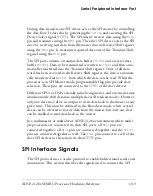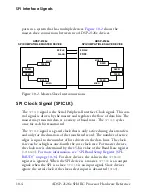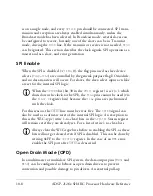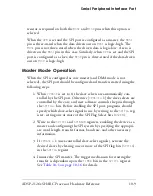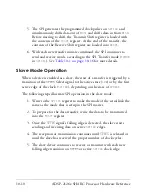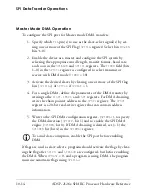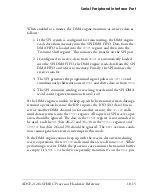
ADSP-2126x SHARC Processor Hardware Reference
10-3
Serial Peripheral Interface Port
During data transfers one SPI device acts as the SPI master by controlling
the data flow. It does this by generating the
SPICLK
and asserting the SPI
Device Select signal (
SPIDS
). The SPI master receives data using the
MISO
pin and transmits using the
MOSI
pin. The other SPI device acts as the SPI
slave by receiving new data from the master into its Receive Shift register
using the
MOSI
pin. It transmits requested data out of the Transmit Shift
register using the
MISO
pin.
The SPI port contains a transmit data buffer (
TXSPI
) and a receive data
buffer (
RXSPI
). Data to be transmitted is written to
TXSPI
and then auto-
matically transferred into the Transmit Shift register. Once a full data
word has been received in the Receive Shift register, the data is automati-
cally transferred into
RXSPI
, from which the data can be read. When the
processor is in SPI Master mode, programmable flag pins provide slave
selection. These pins are connected to the
SPIDS
of the slave devices.
Different CPUs or DSPs can take turns being master, and one master may
simultaneously shift data into multiple slaves (Broadcast mode). However,
only one slave may drive its output to write data back to the master at any
given time. This must be enforced in the Broadcast mode, where several
slaves can be selected to receive data from the master, but only one slave
can be enabled to send data back to the master.
In a multimaster or multidevice ADSP-2126x environment where multi-
ple processors are connected via their SPI ports, all
MOSI
pins are
connected together, all
MISO
pins are connected together, and the
SPICLK
pins are connected together as well. The
FLGx
pins connect to each of the
slave SPI devices in the system via their
SPIDS
pins.
SPI Interface Signals
The SPI protocol uses a 4-wire protocol to enable bidirectional serial com-
munication. This section describes the signals used to connect the SPI
Summary of Contents for ADSP-21261 SHARC
Page 30: ...Contents xxx ADSP 2126x SHARC Processor Hardware Reference ...
Page 40: ...Register Diagram Conventions xl ADSP 2126x SHARC Processor Hardware Reference ...
Page 58: ...Differences From Previous SHARCs 1 18 ADSP 2126x SHARC Processor Hardware Reference ...
Page 112: ...Secondary Processing Element PEy 2 54 ADSP 2126x SHARC Processor Hardware Reference ...
Page 178: ...Summary 3 66 ADSP 2126x SHARC Processor Hardware Reference ...
Page 204: ...DAG Instruction Summary 4 26 ADSP 2126x SHARC Processor Hardware Reference ...
Page 322: ...Setting Up DMA 7 32 ADSP 2126x SHARC Processor Hardware Reference ...
Page 436: ...SPORT Programming Examples 9 86 ADSP 2126x SHARC Processor Hardware Reference ...
Page 521: ...ADSP 2126x SHARC Processor Hardware Reference 11 31 Input Data Port rts IDP_ISR end ...
Page 522: ...Input Data Port Programming Example 11 32 ADSP 2126x SHARC Processor Hardware Reference ...
Page 590: ...Timer Programming Examples 14 20 ADSP 2126x SHARC Processor Hardware Reference ...
Page 796: ...I O Processor Registers A 174 ADSP 2126x SHARC Processor Hardware Reference ...
Page 800: ...B 4 ADSP 2126x SHARC Processor Core Manual ...
Page 846: ...Index I 36 ADSP 2126x SHARC Processor Hardware Reference ...















